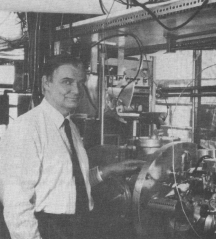Paul Marmet
Paul Marmet; (20 May 1932 - 20 May 2005) was a Canadian physicist and professor, best known for developing, along with his mentor Larkin Kerwin, a high resolution electron selector for the study of electronic states of negative ions. This instrument, along with a mass spectrometer he developed, was widely used by scientists for electron scattering studies which led to the discovery of enhanced vibrational excitation in nitrogen, and for the study of free radicals.
| Paul Marmet | |
|---|---|
 Paul Marmet (1932 - 2005) | |
| Born |
20 May 1932 Lévis, Quebec |
| Died |
20 May 2005 (aged 73) Ottawa, Ontario, Canada |
| Citizenship | Canadian |
| Fields | Physics |
| Institutions |
Professor of Physics, Université Laval Director, Laboratory for Atomic and Molecular Physics, Université Laval Senior Researcher, Herzberg Institute of Astrophysics, National Research Council (Canada) Assistant Professor of Physics, University of Ottawa |
| Alma mater | Université Laval |
| Known for | Low-energy Monoenergetic Electron Spectrometer |
| Notable awards |
Herzberg Medal of the Canadian Association of Physicists Leo Pariseau Prize of the French Canadian Association for the Advancement of Science(ACFAS) Service Award, Royal Astronomical Society of Canada Officer, Order of Canada |
| Spouse | Jacqueline Marmet |
Career
Beginning in 1967 Marmet served as director of the laboratory for Atomic and Molecular Physics at Laval University in Quebec City, Canada, serving in that role until 1982. From 1983 to 1990, Marmet was a senior researcher at the Herzberg Institute of Astrophysics of the National Research Council of Canada in Ottawa. In 1990 Marmet was an Assistant Professor of Physics at the University of Ottawa.[1]
Theories
Marmet was a harsh critic of the Copenhagen Interpretation of Quantum Mechanics. He proposed that there were three insurmountable difficulties in the Copenhagen Interpretation, including the negation of causality and realism, along with the need for "involvement of infinite and imaginary velocities or masses".[2][3]
Red Shift and the Cosmological Constant
Marmet was an outspoken critic of the Big Bang cosmological model. He stated that the model introduced a number of deficiencies, including a value for the critical density of the universe which exceeded observational results by two orders of magnitude.[4]
He proposed that an "unlimited and ageless universe"[5] more favorably explained the nature of the universe by doing away with the deficiences of the Big Bang model.
Marmet explained:
- The cosmological redshift can be more easily explained by mechanisms that are far simpler than the Doppler effect proposed by Big Bang theory;
- An unlimited, ageless universe does not require a critical density that exceeds observations by two orders of magnitude;
- Olber's Paradox, included in Big Bang cosmology, is resolved when observing the universe at wavelengths below 1mm.
Bibliography
Paul Marmet published more than 100 original research papers, as well as a number of books, websites and animated demonstrations for the teaching of Physics.[1]
References
- ↑ 1.0 1.1 Marmet, Paul. "About the Author". Newton Physics. Retrieved 12 February 2013.
- ↑ Marmet, Paul. "Promulgation of Absurdities". Absurdities in Modern Physics. Retrieved 12 February 2013.
- ↑ Marmet, Paul (1993). Absurdities in Modern Physics. Éditions du Nordir. p. 144. ISBN 0921272154.
- ↑ Marmet, Paul (December 1992). "The Cosmological Constant and the Redshift of Quasars". IEEE Transactions on Plasma Science 20 (6): 958–964. doi:10.1109/27.199557. Retrieved 12 February 2013.
- ↑ Marmet, Paul. "The Cosmological Constant and the Redshift of Quasars". Newton Physics. Retrieved 12 February 2013.